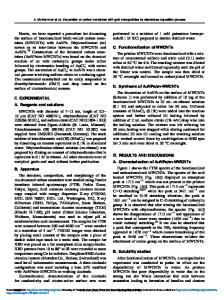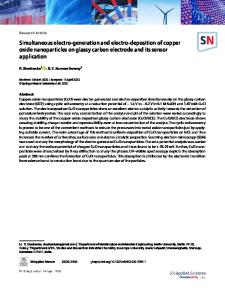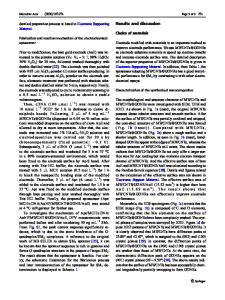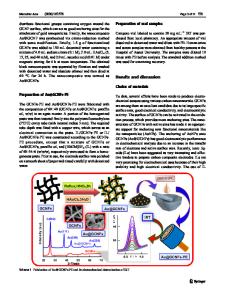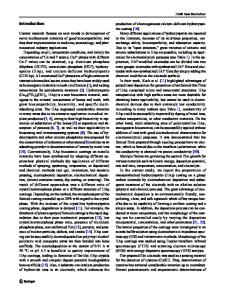Electroless deposition of gold nanoparticles on carbon nanopipette electrode for electrochemical detection of catecholam
- PDF / 901,359 Bytes
- 7 Pages / 595.276 x 790.866 pts Page_size
- 49 Downloads / 362 Views
ORIGINAL PAPER
Electroless deposition of gold nanoparticles on carbon nanopipette electrode for electrochemical detection of catecholamines released from PC12 cells Hetong Qi 1
&
Jiajia Song 2 & Mengyue Zhang 1 & Siyu Tian 2 & Honglan Qi 2
Received: 5 March 2020 / Accepted: 25 September 2020 # Springer-Verlag GmbH Austria, part of Springer Nature 2020
Abstract An electroless deposition method is reported for the fabrication of gold nanoparticles (Au NPs) modified carbon nanopipette electrode (CNPE) for sensitive electrochemical detection of dopamine (DA) in aqueous solution and catecholamines released from PC12 cells. A CNPE is fabricated by chemical vapor deposition with a carbon layer onto nanocapillary and then contacted with copper (Cu) wire. Cu wire of CNPE is able to serve as reducing agent for electroless deposition of Au NPs on the CNPE because the potential of Cu2+/Cu is more negative than that of AuCl4−/Au. The method is simple, time-saving, and environmentally friendly. Field emission scanning electron microscopy, energy-dispersive X-ray analysis, and electrochemical techniques confirm the successful fabrication of the Au NPs/CNPE. Furthermore, Au NPs/CNPE exhibits a good sensing activity for DA oxidation with a wide linear determination range of 0.1–8 μmol/L and a low detection limit of 6 nmol/L. The Au NPs/CNPE can be potentially applied for measurement of catecholamines released from PC12 cells. This present work is believed to be beneficial to the design and development of active metal catalysts onto nanoelectrodes for the detection of electroactive biological molecules in living cells. Keywords Electroless deposition . Gold nanoparticles . Carbon nanopipette electrode . Dopamine
Introduction Smaller (i.e., nanometer-sized) electrodes, such as carbon nanopipette electrode (CNPE) [1–4] and nanotip conical carbon fiber microelectrode [5–8] could be highly useful for the study of electrochemistry and neurochemistry because of its excellent physical and chemical properties. CNPE, nanometer-scale pipettes covered with carbon by chemical vapor deposition (CVD) method, have been widely used in the Hetong Qi and Jiajia Song contributed equally to this work. Electronic supplementary material The online version of this article (https://doi.org/10.1007/s00604-020-04569-0) contains supplementary material, which is available to authorized users. * Hetong Qi [email protected] 1
School of Chemistry, Xi’an Jiaotong University, Xi’an 710049, People’s Republic of China
2
Key Laboratory of Analytical Chemistry for Life Science of Shaanxi Province, School of Chemistry and Chemical Engineering, Shaanxi Normal University, Xi’an 710062, People’s Republic of China
electrochemical detection of neurochemicals at the level of living cells or in vivo owing to their low cost and wide potential window [9–12]. For instance, Venton et al. prepared a CNPE or cavity CNPE for high temporal resolution and sensitive detection of endogenous or exogenously dopamine from the Drosophila larvae [9] and mouse brain slices [10], r
Data Loading...
